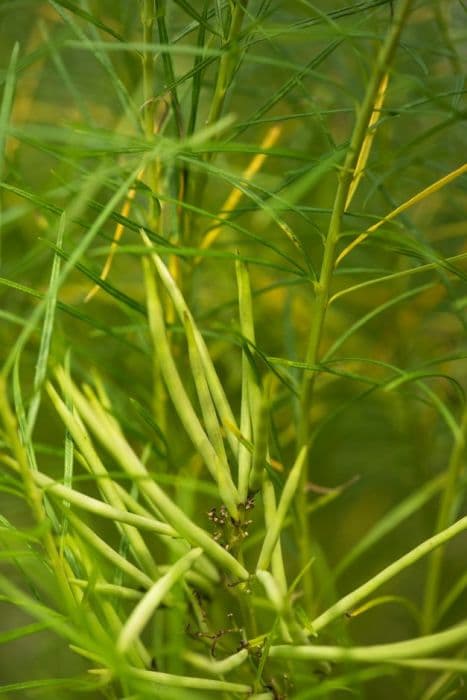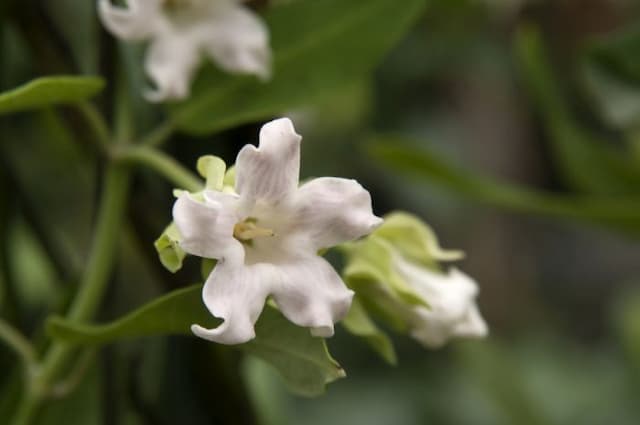Eastern Bluestar Amsonia tabernaemontana

ABOUT
Commonly known as the Eastern Bluestar, this plant is adorned with clusters of small, star-shaped flowers that exhibit a soft, sky-blue hue, which contributes to its common name. The flowers are neatly arranged in loose clusters above the foliage, presenting an airy and delicate appearance. Its leaves are narrow and lance-shaped, with a slightly glossy surface, and they turn to attractive shades of golden-yellow to orange before they fall off in the autumn. The stems of the Eastern Bluestar are erect and sturdy, branching out to create a bushy appearance. The overall shape of the plant is mounded with a neat, garden-worthy presence. Its foliage, aligned in an alternate fashion along the stems, adds a fine-textured greenery that acts as a perfect backdrop for the charming blooms. The seed pods that appear after flowering are slender and elongated; they provide a different visual interest as they mature. The Eastern Bluestar is a perennial plant, meaning it will return year after year, regrowing from its root system to grace gardens with its tranquil beauty and resilience.
About this plant
 Names
NamesFamily
Apocynaceae
Synonyms
Eastern Bluestar, Blue Dogbane, Willow Amsonia, Woodland Bluestar, Tabernaemontana's Amsonia
Common names
Amsonia lanceolata, Amsonia latifolia, Amsonia repens, Amsonia tabernaemontana var. salicifolia.
 Toxicity
ToxicityTo humans
Eastern bluestar is not commonly known as a toxic plant to humans. There is little information suggesting significant toxic effects resulting from ingestion. However, as with many plants, it may cause mild stomach upset if ingested in large quantities due to its bitter constituents. To remain safe, it is generally advised to avoid eating any part of ornamental plants like Eastern bluestar.
To pets
Eastern bluestar is also not widely recognized as a poisonous plant to pets. It is not typically listed among plants that pose serious risks to dogs, cats, or other domestic animals. However, ingestion of plant material can cause gastrointestinal irritation in some pets, leading to symptoms like vomiting or diarrhea. Pet owners should still exercise caution and prevent pets from consuming this or any ornamental plant.
 Characteristics
CharacteristicsLife cycle
Perennials
Foliage type
Deciduous
Color of leaves
Green
Flower color
Blue
Height
2-3 feet (0.6-0.9 meters)
Spread
2-3 feet (0.6-0.9 meters)
Plant type
Shrub
Hardiness zones
3-9
Native area
North America
Benefits
 General Benefits
General Benefits- Attractive Aesthetic: Produces star-shaped blue flowers adding beauty to gardens.
- Pollinator Support: Attracts bees, butterflies, and other beneficial pollinators.
- Drought Tolerance: Once established, it can withstand periods of low water availability.
- Deer Resistance: Generally resistant to browsing by deer, making it suitable for rural gardens.
- Seasonal Interest: Offers a range of seasonal changes, from spring flowers to fall foliage color.
- Native Planting: As a native species, it supports local ecosystems and biodiversity.
- Erosion Control: Its root system can help stabilize soil and prevent erosion.
- Low Maintenance: Requires minimal care once established, making it a good choice for low-maintenance landscapes.
 Medical Properties
Medical PropertiesThis plant is not used for medical purposes.
 Air-purifying Qualities
Air-purifying QualitiesThis plant is not specifically known for air purifying qualities.
 Other Uses
Other Uses- Amsonia tabernaemontana, commonly known as Eastern bluestar, can be used as a natural dye for fabrics, yielding a blue or yellow color depending on the mordant used.
- The sap of Eastern bluestar has been traditionally used as a substitute for rubber in certain low-grade industrial applications.
- The fibrous stems of the plant were historically used to make twine and rope by indigenous communities.
- Gardeners may use Eastern bluestar as a deer-resistant planting option, as deer tend to avoid it due to its bitter-tasting sap.
- The plant’s hardy and spreading nature can be employed to stabilize soil and prevent erosion on slopes or banks.
- Eastern bluestar's dense growth habit makes it useful as a privacy screen or hedge in landscaping.
- The striking blue flowers of the plant are used in floral arrangements, offering a splash of color and a wildflower aesthetic.
- Because of its resilient nature, it can be used in xeriscaping, contributing to water conservation in garden design.
- Educational gardens may include Eastern bluestar to teach about native plant species and their roles in local ecosystems.
- Insectariums and butterfly gardens plant Eastern bluestar to attract pollinators like bees and butterflies due to its nectar-rich flowers.
Interesting Facts
 Feng Shui
Feng ShuiThe Eastern Bluestar is not used in Feng Shui practice.
 Zodiac Sign Compitability
Zodiac Sign CompitabilityThe Eastern Bluestar is not used in astrology practice.
 Plant Symbolism
Plant Symbolism- Resilience - Amsonia tabernaemontana, commonly known as the Eastern Bluestar, often symbolizes resilience because it's hardy and can withstand tough environments.
- Patience - This plant has a slow growth rate, representing patience as it takes time to mature and bloom.
- Endurance - The Eastern Bluestar has a long blooming period and symbolizes endurance as it maintains its beauty over time.
 Water
WaterThe Blue Star (Amsonia tabernaemontana) should be watered deeply but infrequently, ensuring the soil is allowed to dry between waterings to prevent root rot. In general, water the Blue Star with about 1 inch (approximately 0.6 gallons) of water per week during the growing season. The amount of water may need to be adjusted based on rainfall and temperature, with reduced watering in the fall as the plant goes dormant. During the hottest part of the summer, you may need to water twice a week, especially if the plant is in well-draining soil or a container. Always check the top inch of soil for dryness before watering again.
 Light
LightFor optimal growth, the Blue Star (Amsonia tabernaemontana) should be planted in a location that receives full sun to partial shade. The plant thrives best with at least 6 hours of direct sunlight daily, but it can also tolerate some afternoon shade, especially in hotter climates. A spot that provides morning sunlight and protection from the intense heat of the afternoon sun is ideal for the Blue Star.
 Temperature
TemperatureThe Blue Star (Amsonia tabernaemontana) is hardy and can tolerate a range of temperatures, growing best in the range of 60°F to 80°F. It can survive minimum winter temperatures down to around -20°F and summer highs up to 90°F without issue. However, it is crucial to avoid sudden temperature changes and to protect the plant from frost, which can damage new growth.
 Pruning
PruningPruning the Blue Star (Amsonia tabernaemontana) is important for maintaining a neat appearance and promoting vigorous growth. Prune the plant back by one-third in late winter or early spring before new growth begins. This helps encourage bushier growth and prevents the plant from becoming too leggy. Additionally, removing spent flowers and any damaged or dead stems throughout the growing season will keep the plant looking tidy and can encourage additional blooming.
 Cleaning
CleaningAs needed
 Soil
SoilThe best soil mix for Eastern Bluestar should be well-draining and fertile with a pH range of 6.0 to 7.5. A mixture of loam, sand, and compost is ideal, with peat or leaf mold to enhance fertility and moisture retention.
 Repotting
RepottingEastern Bluestar typically does not need frequent repotting as it prefers to be undisturbed; repotting every 3-4 years or when it outgrows its current container is sufficient.
 Humidity & Misting
Humidity & MistingEastern Bluestar thrives in average humidity levels found in typical outdoor environments and does not require any special humidity considerations.
 Suitable locations
Suitable locationsIndoor
Place Eastern Bluestar near a sunny window and water moderately.
Outdoor
Plant in full sun to partial shade in well-draining soil.
Hardiness zone
3-9 USDA.
 Life cycle
Life cycleAmsonia tabernaemontana, commonly known as the Eastern bluestar, begins its life cycle as a seed, which germinates in late spring when the soil temperatures warm up. After germination, seedlings establish a small rosette of leaves in their first growing season, focusing on the development of a robust root system. The following year, the plant enters a vegetative stage, producing larger leaves and beginning to form a woody base, typical of a perennial. In its third year and beyond, the Eastern bluestar matures and starts its reproductive phase, typically flowering in late spring with clusters of star-shaped, blue flowers that attract pollinators. After pollination, the flowers develop into slender, pod-like follicles containing seeds that, when mature, are released into the environment to continue the propagation cycle. Throughout its life, Amsonia tabernaemontana also undergoes seasonal senescence in autumn, with leaves often turning a striking golden-yellow before dying back to the ground, repeating the cycle the next spring.
 Propogation
PropogationPropogation time
Spring-Early Summer
Propogation: The Eastern Bluestar (Amsonia tabernaemontana) is best propagated by seed, with the ideal time for sowing being in the fall to allow for a natural stratification period over the winter months. To propagate Eastern Bluestar using this method, seeds should be sown in a seed-starting mix, barely covered with the medium, and kept moist. After sowing, the container with seeds should be left outside to experience the winter chill, which aids in breaking seed dormancy. Come spring, with warmer temperatures, the seeds will germinate. This mimics the natural cycle the seeds would undergo in their native environment, leading to a higher germination rate and stronger seedlings.









